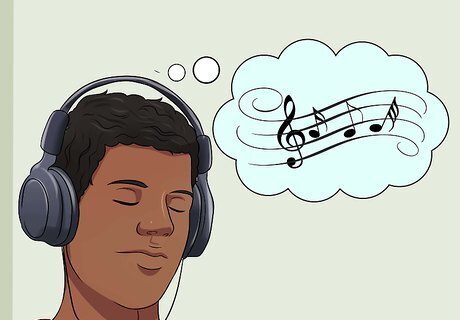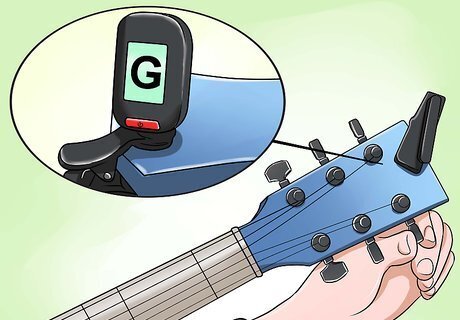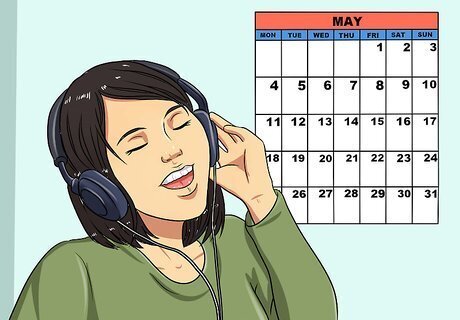
views
Establishing a Foundation for Ear Training

Protect your hearing. Hearing loss is the third most common problem in the U.S. and can result from overexposure to chronic loud noise, like the kind you might listen to with headphones. Damaged hearing can even limit your physical ability to hear a certain range of sound or cause a persistent ringing in your ears. Defend your ears by listening to music at moderate to low volumes and wearing earplugs around loud, chronic noises, like a construction site. Sounds as loud or louder than normal traffic can be harmful to your hearing.

Know the theory behind the sound. Western music is represented by a set of rules, referred to as music theory, and by knowing these rules you can help your mind interpret the sounds you hear. Understanding that a basic chord has at least 3 notes in it, for example, will help your ear pick out the 3 different tones. You'll want to have a functional understanding of: The musical staff and bass and treble clefs. The staff is comprised of 5 lines and 4 spaces that represent the notes in a scale, with each line/space corresponding to a white key on the keyboard. A treble clef, which is shaped similar to an "and" sign (&), or a bass clef, shaped similarly to a backward C with a colon (:), start each staff. Ledger lines. Ledger lines are small lines drawn above or below the 5-line 4-space staff to represent notes that are higher or lower than the common notes of the regular staff. Common intervals. Music is arranged according to lines of a staff or, comparable, to the white and black keys of a keyboard. The distance between the 2 neighboring white keys is a whole step, also called a second. Black keys represent half steps between white key whole step intervals. A major third, like the interval between C and E, is made up of 2 whole steps (C, D, E) or 4 half steps (C, C#, D, D#, E). Scale degrees, which are the special names for notes your scale. These names, starting from the root of a major scale like C major, are: tonic, supertonic, mediant, subdominant, dominant, submediant, with the seventh interval called a leading tone if the interval between it and the tonic is a whole step or subtonic if that interval is a half step.

Identify the kind of ear training you want to do. There are many goals you might want to accomplish over the course of your ear training. One of the most impressive is "perfect pitch," which is where an individual can identify and recreate a musical tone without any point of reference. Even among master musicians, perfect pitch is rare, but more reasonably you might hope to gain: The ability to identify intervals, musical keys, and/or recreate notes from memory. The ability to tune pitches by telling if they are sharp or flat. The ability to imagine the sound of music from notes without a point of reference.

Listen to various kinds of music. Different regions and cultures produce different kinds of music, and knowing these will further expand the powers of your musical ear. Some Asiatic music is based around a 5-note scale, called pentatonic, while Western music is characterized by an 8-note scale. Listening to classical music can expose your ear to many difficult and intricate composition. There are also many difficult intervals that are infrequently occurring in contemporary music that are more common in a classic style, like opera. Sing along to your favorite pop artists in the car. Though you should be careful when doing this, as it is easy to pump the volume of your favorite tunes and sing too loudly, which can lead to vocal strain.

Learn an instrument. Throughout the process of mastering an instrument, you will be exposed to musical theory and practical exercises. Your practical exercises likely take the form of learning specific songs for practice. Through these songs you'll gain a better understanding and intuition of how notes work within a piece of music. Studying piano will familiarize you with both treble and bass clefs, as well as different keys and styles. Due to its versatility, this instrument is considered to be ideal for studying and training music theory.

Train with a professional. A professional musician has years of experience tuning instruments, listening to music, and hitting pitches spot on in the hopes of creating the best possible music. Working with such a person will be an invaluable resource for developing your ear.
Utilizing Specific Ear Training Techniques

Do use moveable solfege. The great thing about the "Do, Re, Mi" scale, called solfege, is that it can be done without an instrument. Moveable solfege is frequently used by vocalists, as it teaches you relative pitch with relation to the scale of notes for the key in which you are singing. If you already know the solfege scale and only need a refresher, check out how to sight sing. The basic solfege scale is: Do Re Mi Fa Sol La Ti Do. Like the notes of a normal musical scale, these tones repeat at every octave (8-note) interval. Practice by starting your solfege scale on the root of your key. For example, you could start "Do" on C, and with each white note interval up the keyboard, you ascend the solfege scale.

Root out the root notes. If you know how chords and scales naturally develop from a root note, like C, you will be able to recognize more complicated arrangements of notes. For example, if you are already well familiar with a diminished chord, once you hear the tonic (root note) of it, you will be able to predict, either with your voice, your instrument, or in your head, the sound of that chord. Practicing scales and arpeggios encourage ear training by conditioning it to innately know and predict the flow of notes through a piece of music. Some might believe scales boring, but true musicians know the value of this kind of practice.

Sing your own melodies to practice intervals. Singing is something you are able to do most of the time when you're on your own. Choose a note and start practicing your own made-up melody. Try to include intervals or chord structure you have learned, like augmented chords or diminished chords, which are more difficult than major or minor chords. Do this frequently to gain greater familiarity and mastery over your mental representation of the sounds you have learned.

Sing along with a single instrument while listening to music. This can help you better internalize the role of that instrument in the music. You might sing along with the rhythm of the bass, or follow along with a reoccurring cymbal. Singing along with specific instruments also challenges your ear, as you will have to listen to the sound carefully to match it.

Compare yourself to a musical point of reference. Especially when singing without reference or accompaniment, it can be easy for your pitch to become flat. Check that you are maintaining your pitch either with a tuned instrument, a digital pitch tuner, or a pitch pipe.

Consider making use of an ear training app. There are a few ear training apps available now that are designed to test and analyze your musical ear. Some even include ear training exercises. You should investigate these through an online search before purchasing; some might be oriented toward sound engineers and not necessarily students of music.
Maintaining Your Trained Ear

Be consistent while learning. Training your ear to a certain level may take a very long time. Professional musicians train their entire careers to perfect their musical ear. Even so, perfect pitch is still something of a mystery to scientists and will likely take you much practice for you to attain. Note that achieving perfect pitch may not be possible, but it's also not necessary. Relative pitch is just as useful!

Set aside regular time in your schedule to practice. If you're a vocalist, this might entail putting on some soft music and singing along with it, or if you're an instrumentalist you might sit down at your instrument after breakfast every day. Hearing the movement of sound among intervals will reinforce these in your mind.

Jam with other musicians. These experts can help you fine-tune your technique, but they can also point out areas where your musical ear might be weak. Once you've identified a specific problem, like difficulty hitting high C because it's close to the top of your vocal range, you can practice it until you improve.

Exercise your ear regularly. Once your ear for music improves, you should challenge it often, either at your instrument or with your voice. Use your imagination to recreate sounds that you have heard and try to capture the quality of sound exactly in your head. You might start with a tonal element that's easier to hear, like the root of the chord. Then you can add new tones to it with an instrument, or move vocally from that root to discover the other tones that are a part of the chord progression. This is how you learn to harmonize.




















Comments
0 comment